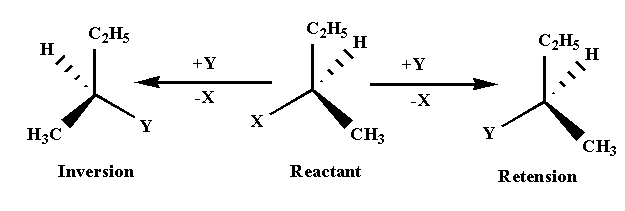
Differentiate between retention and inversion.
Answer
516.7k+ views
Hint: When the nucleophile attacks the chiral carbon from the same side where the leaving group is present than retention of configuration is obtained. When the nucleophile attacks the chiral carbon from the opposite direction where the leaving group is present then inversion of configuration is obtained.
Complete step by step answer:

Note: The nucleophilic substitution reaction which follows the ${S_N}2$ type of mechanism shows inversion of configuration. In nucleophilic substitution reactions which follow ${S_N}1$type of mechanism, a racemic mixture is formed out of which one product shows retention in configuration and another product shows inversion of configuration.
Complete step by step answer:

| Retention | Inversion |
| Retention is defined as a state where absolute configuration and relative configuration of the atom or a molecule is maintained. | Inversion is defined as a state where absolute configuration and relative configuration of the atom or a molecule is not maintained. In the inversion of configuration the chiral carbon and the group attached to the chiral carbon remains change their position during the reaction to form product, that means the reactant and product does not resemble each other. |
| In the retention of configuration the chiral carbon and the group attached to the chiral carbon remain in the same position before and after the reaction. | Inversion is the back attack of the nucleophile takes place and in the retention front attack of nucleophile takes place. |
| The retention in configuration changes the R- configuration of the compound into R and S-configuration of the compound to S. | The inversion in configuration changes the R- configuration of the compound into S and S-configuration of the compound to R. |
Note: The nucleophilic substitution reaction which follows the ${S_N}2$ type of mechanism shows inversion of configuration. In nucleophilic substitution reactions which follow ${S_N}1$type of mechanism, a racemic mixture is formed out of which one product shows retention in configuration and another product shows inversion of configuration.
Recently Updated Pages
The number of solutions in x in 02pi for which sqrt class 12 maths CBSE

Write any two methods of preparation of phenol Give class 12 chemistry CBSE

Differentiate between action potential and resting class 12 biology CBSE

Two plane mirrors arranged at right angles to each class 12 physics CBSE

Which of the following molecules is are chiral A I class 12 chemistry CBSE

Name different types of neurons and give one function class 12 biology CBSE

Trending doubts
Which are the Top 10 Largest Countries of the World?

What are the major means of transport Explain each class 12 social science CBSE

Draw a labelled sketch of the human eye class 12 physics CBSE

Differentiate between insitu conservation and exsitu class 12 biology CBSE

The computer jargonwwww stands for Aworld wide web class 12 physics CBSE

State the principle of an ac generator and explain class 12 physics CBSE




